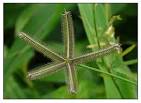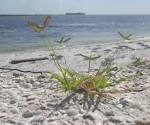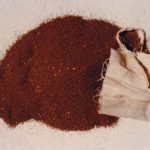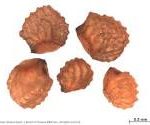Dactyloctenium aegyptium
Uses
India (Rajasthan): the rugose seed grains are eaten cooked into a thick porridge or the husked seeds are boiled in water to a thick mush. Mixed with semi-ground Phaseolus aconitifolius, Jacq. [Fabaceae], the grains are prepared into a dish called Keech, which is much relished. Also reported mixed with Bajra (millet), and other grains (for bread-making); (Bhil group): Church reports two grain samples, from different areas, which he states are identical, but with different Madras Presidency: grains eaten, Vernacular names: 1) Anchu Manchu and, 2) Mali or Manebhi. The first is reported unsavory and hard to chew, constipating, bloating and urine inhibiting. The second, which is made into bread, is reported much relished. Chad (central): grain eaten. Sudan (Kordofan, Darfur): seeds ground into a flour to make Kisra, a thin local bread; or porridge. In extreme famine conditions the grain, which is also collected by ants, has been dug from underground and eaten.
Additional Information
- Name Authority:
- (L) Beauv.; Willd.
- Vernaculars:
- India (Rajasthan, Jaisalmer district, ): Makara, Manchi. Rajasthan (western): Makta. (Bhil group): Anchu Manchu, Mali. Chad (central)- Arabic: Abou Asabé ['Father of fingers']. Sudan: Koreeb. Tamil: Muttengapilloo. Telugu:Tamida, Sodee
- Misc:
- Soil types favored by plant - Chad (central): clayey, sandy; black soil along the borders of ponds, swamps and bogs. India: along water channels; Bhil area: brown soil. Chemical composition (Sudan sample): Protein (crude) = 13.1% (dry). Oil = 1.9% (dry). Fibre (crude) = 4.4% (dry). Ash (insoluble) = 8.3% (dry). Sulphur = .18% (dry). Potassium = 0.39% (dry). Manganese = 0.22% (dry). Calcium = 1.07% (dry). Na = 0.02% (dry). K = 0.30% (dry). Zinc = 69mg/kg-1 Iron = 121mg/kg-1 (dry). Mn = 425kg/kg-1 (dry). Copper = 7mg/kg-1 (dry). Aluminum = 172mg/kg-1 (dry). Carbohydrate (soluble): Starch = 46.9% (dry). Sucrose = 1.2% (dry). D-glucose = 0.2%(dry). D-fructose = 1.4% (dry). Amino acids (g [16g N ]-1): Aspartic acid = 6.1g. Threonine = 3.7%. Serine = 4.8g. Glutamic acid = 27.6g. Proline = 7.1g. Glycine = 3.5g. Alanine = 7.5g. Valine = 5.8g. Cysteine = 1.5g. Methionine = 3.2g. Isoleucine = 4.8g. Leucine = 9.9g. Tyrosine = 3.5g. Phenylalanine = 6.8g. Histidine = 2.4g. Lysine = 2.0g. Arginine = 4.2g. Fatty acids (saturated): 14:0 = <0.1g/100g-1. 16:0 = 21.5. 18:0 = 5.2. 22:0 = 0.6. 24:0 = <0.1g/100g-1; (monounsaturated): 16:1 = 0.1. 18:1 = 42.0. 20:1 = 0.4; (polyunsaturated): 18:2 = 28.5. 18:3 = 1.5. (Chemical composition (after Paton & Dunlop (grams per 100g) (Anchu Manchu): Proteid = 12.87g. Fat = 2.08g. Carbohydrate (soluble) = 64.03g. Fibre = 4.86g. Ash = 4.58g. Water = 11.58g. Calories = 335. (Mali ): Proteid = 8.41g. Fat = 1.45g. Carbohydrate (soluble) = 38.97g. Fibre = 36.95g. Water = 8.48g. Calories = 201.




